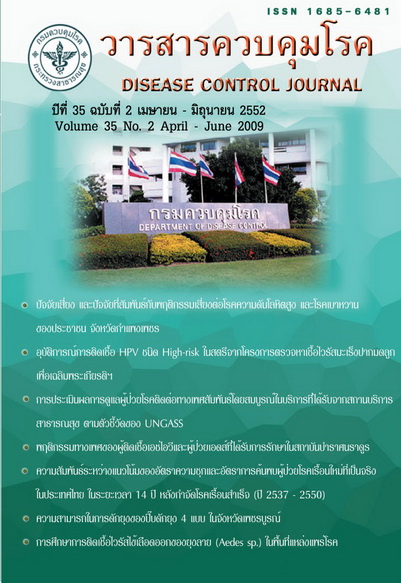Dengue Virus infection of Aedes Mosqutoes in Hyperendemic Area of DF/DHF
Keywords:
Dengue and Dengue Homorrhagic Fever, Aedes mosqutoesAbstract
This study aimed to determine dengue virus infection rates in Aedes mosquitoes from Nakhon sri Thammarat and Phetchabun Province. Aedes aegypti and Ae. albopictus were caught from the patient's houses, neighbor's houses which located in the radius 100 meters from patient's houses and houses in village without patients.. Aedes mosquitoes were collected in rainy season and summer during June 2004 to May, 2005. Dengue virus in mosquitoes was detected by RT-PCR. The results revealed that total 3,459 mosquitoes were collected ( 1,897 of Ae. aegypti and 1,562 of Ae. albopictus). The 1,885 Aedes mosquitoes were caught from Nakhon sri Thammarat, composed of 464 Ae. aegypti and 1,421 Ae. Albopictus. In the rainy season, Ae. Albopictus was more prominent than Ae. aegypti approximately 3 times. The 0.92% of Ae. aegypti was infected by DENV-1 while Ae. albopictus was infected by DENV-1 (0.40%) and DENV-3 (0.12%).The 1,574 of Aedes mosquitoes were isolated as 1,433 of Ae. aegypti and 141 of Ae. Albopictus from Phetchabun Province. The population of both species is increasing in the rainy season which Ae. Aegypti more than Ae. albopictus approximately 10 times. Dengue infection rates in Ae. aegypti was 1.76% identified as DENV-1(0.14%) and DENV-4 (1.62%).
Downloads
References
2. Monath TP. Dengue-the risk to developed and developing countries. Proc Natl Acad Sci USA 1994; 91: 2395-400.
3. Innis BL. Dengue and dengue hemorrhagic fever. In: Porterfield JS. editor. Exotic viral infections. London: Chapman and Hall; 1995. 103-46 p.
4. Johnson BW, Chambers TV, Crabtree MB, et al. Growth characteristics of chimerivax TM- DEN2 vaccine virus in Aedes aegypti and Aedes albopictus mosquitoes. Am J Trop Med Hyg 2002; 67: 260-5.
5. Novak R. The Asian tiger mosquito, Aedes albopictus. Wing Beats 1992; 3: 5. 20 May 2005. (http://www.rci.rutgers. edu/~insects/sp8.htm).
6. Hawley WA. The biology of Aedes albopictus. J Am Mosq Control Assoc 1988; 4: 1-40.
7. Thu HM, Aye KM, Thein S. The effect of temperature and humidity on dengue virus propagation in Aedes aegypti mosquitoes. Southeast Asian J Trop Med Public Health 1998; 29: 280-4.
8. Romero-vivas CM, Leake CJ, Falconar AKI . Determination of dengue virus serotypes in individual Aedes aegypti mosquitoes in Colombia. Medical and Veterinary Entomology 1998:12; 284-8.
9. Chung YK, Pang FY. Dengue virus infection rate in field populations of female Aedes aegypti and Aedes albopictus in Singapore. Trop Med Int Health 2002; 7: 322-30.
10. อุษาวดี ถาวระ. ยุงลายพาหะโรคไข้เลือดออก. ใน: อุษาวดี ถาวระ บรรณาธิการ. ชีววิทยา นิเวศวิทยา และการควบคุมยุงในประเทศไทย. สถาบันวิจัยวิทยาศาสตร์สาธารณสุข กรมวิทยาศาสตร์การแพทย์ กระทรวงสาธารณสุข. กรุงเทพมหานคร: บริษัทดีไซร์จำกัด; 2544. น 1-41.
Downloads
Published
How to Cite
Issue
Section
License
Articles published in the Disease Control Journal are considered as academic work, research or analysis of the personal opinion of the authors, not the opinion of the Thailand Department of Disease Control or editorial team. The authors must be responsible for their articles.


.png)



